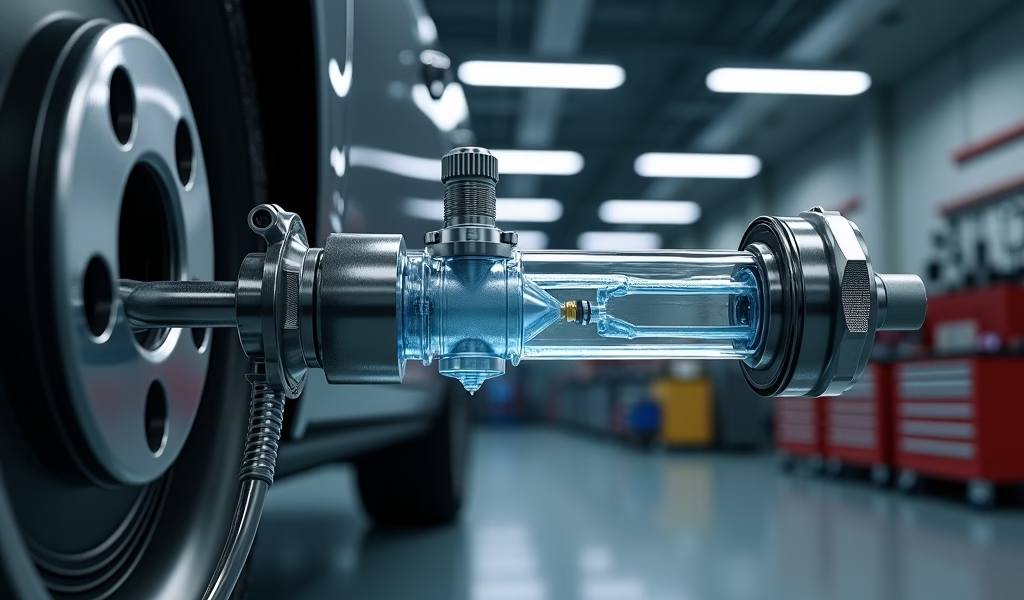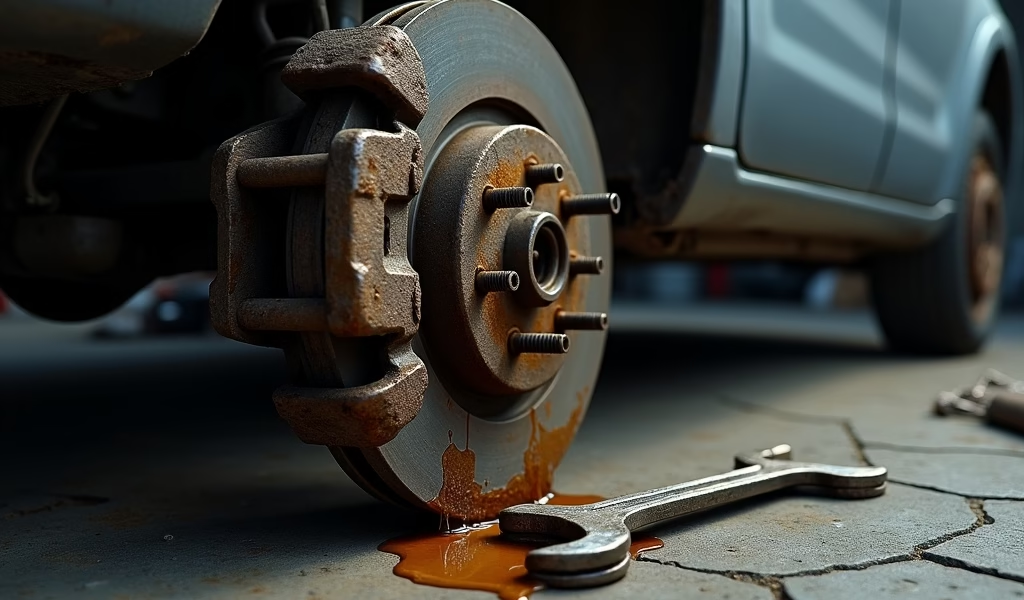Overview
Residual pressure valves (RPVs) maintain a small amount of pressure in brake lines to prevent air infiltration and ensure immediate brake response, with drum brake systems requiring 8-10 psi valves while disc brakes need minimal or no residual pressure. Proper maintenance of these valves includes regular inspection, correct bleeding techniques, selecting appropriate replacement parts, proper installation, and monitoring system performance after service to ensure optimal braking safety.
Table of Contents
- Understanding Residual Pressure Valve Function
- The Importance of Residual Pressure in Brake Systems
- Common Issues with Residual Pressure Valves
- Diagnosing Residual Pressure Valve Problems
- Tip 1: Regular Brake System Inspection
- Tip 2: Proper Bleeding Techniques for Systems with RPVs
- Tip 3: Selecting the Right Replacement Valve
- Tip 4: Correct Installation Practices
- Tip 5: Monitoring System Performance After Service
- Conclusion
- Frequently Asked Questions
Understanding Residual Pressure Valve Function
The residual pressure valve function is one of those critical yet often overlooked components in your vehicle’s braking system. As a mechanic with 20 years under my belt, I can tell you these small valves play an outsized role in your safety on the road. In essence, a residual pressure valve (RPV) maintains a small amount of pressure in the brake lines when your foot is off the brake pedal.
Think of it as a loyal guardian that never sleeps. This constant pressure (typically 2-10 psi) serves a crucial purpose: it prevents air from entering the system and keeps the brake components primed for immediate action. For vehicles with drum brakes, this residual pressure helps overcome the return springs that pull the brake shoes away from the drum. In contrast, disc brake systems either don’t need an RPV or use a much lower pressure valve (around 2 psi) to prevent fluid seepage.
The beauty of the residual pressure valve lies in its simplicity. It consists of a spring-loaded check valve that allows fluid to flow freely toward the brake components when you press the pedal. When you release the pedal, it closes partially—not enough to block all return flow, but just enough to maintain that all-important residual pressure. This delicate balance is what gives your brakes that responsive feel when you need them most.
The Importance of Residual Pressure in Brake Systems
Let’s talk about why that little bit of pressure matters so much. When you’re cruising down the highway and suddenly need to stop, you want those brakes to respond instantly—no questions asked, no hesitation. That’s where proper brake system hydraulic pressure maintained by the RPV becomes your best friend.
In drum brake systems, which are still common in rear wheels of many vehicles, the residual pressure ensures that the wheel cylinders remain slightly pressurized. Without this pressure, you’d experience a noticeable delay between pressing the pedal and feeling the brakes engage. That split-second could make the difference between a close call and a collision.
Beyond quick response, the residual pressure valve function contributes to brake system longevity. By keeping a slight pressure in the lines, it helps prevent brake fluid from boiling under extreme conditions. According to research from the Society of Automotive Engineers, this can significantly extend the life of your brake components.
For classic car enthusiasts, understanding RPVs is particularly important. Many vintage vehicles rely heavily on drum brakes, making the proper function of residual pressure valves essential for safe operation. It’s not just about performance—it’s about preserving the integrity of these automotive treasures while keeping them road-worthy.

Common Issues with Residual Pressure Valves
Even the best-designed components can develop problems, and residual pressure valves are no exception. The most common issue I see in my shop is valve clogging. Over time, contaminants in the brake fluid can accumulate in the valve, preventing it from functioning properly. You might notice this as gradually increasing brake pedal travel or a “spongy” feeling when you press the pedal.
Another frequent problem is valve spring fatigue. The spring inside the RPV is under constant tension, and after years of service, it can weaken. When this happens, the valve might not maintain sufficient pressure in the brake lines, leading to delayed brake response. This is particularly dangerous in emergency situations where every millisecond counts.
Improper valve specification is a mistake I’ve seen countless times, especially after DIY brake jobs. Installing a 10 psi residual valve in a disc brake system, for instance, can cause the calipers to drag and wear prematurely. Conversely, using a 2 psi valve with drum brakes might result in sluggish performance and increased pedal travel.
Leakage around the valve body is less common but still worth mentioning. If the valve isn’t properly sealed, or if it’s installed with damaged threads, brake fluid can seep out. This not only creates a safety hazard but also introduces air into the system, further compromising brake performance. Always check for moisture around the valve during routine inspections.
Diagnosing Residual Pressure Valve Problems
Catching RPV issues early can save you from more extensive repairs down the road. The first sign of trouble is often increased pedal travel before the brakes engage. If you find yourself pushing the pedal further than usual, it’s time to investigate. This symptom suggests that the residual pressure isn’t being maintained properly.
A brake pedal that slowly sinks to the floor when held down is another red flag. This could indicate a failing residual pressure valve that’s allowing pressure to bleed off. To test this, press the brake pedal firmly and hold it. If it gradually moves closer to the floor, you likely have an issue with your RPV or another component in the hydraulic system.
Uneven braking performance can also point to RPV problems. If your vehicle pulls to one side during braking, it could be because the residual pressure isn’t balanced between the brake circuits. This is particularly common in vehicles with combination valve assemblies that house multiple functions, including the proportioning valve knee point controls.
For a more definitive diagnosis, a pressure test of the brake system can be revealing. Using a brake pressure gauge, measure the pressure in the system after the pedal is released. For drum brake systems, you should see approximately 8-10 psi of residual pressure. If the reading is significantly lower, your RPV may need attention or replacement.
Tip 1: Regular Brake System Inspection
An ounce of prevention is worth a pound of cure—nowhere is this more true than with your braking system. I recommend a complete brake inspection every 10,000 miles or annually, whichever comes first. During this inspection, pay special attention to the master cylinder, brake lines, and of course, the residual pressure valve.
Start by checking the brake fluid level and condition. Dirty or contaminated fluid is the number one enemy of residual pressure valves. The fluid should be clear with a slight amber tint—if it’s dark brown or has particles floating in it, it’s time for a flush. According to the National Highway Traffic Safety Administration, brake fluid should typically be changed every 2-3 years regardless of mileage.
Inspect all brake lines and connections for signs of leakage, especially around the RPV. Even a minor seep can indicate a developing problem. Look for wet spots or staining on the valve body and surrounding areas. A clean brake system should be completely dry on the outside.
Finally, test the brake pedal feel. With the engine running, press the brake pedal firmly several times, then hold it down. The pedal should feel firm and maintain its position. If it feels soft or gradually sinks, you may have air in the system or a failing residual pressure valve that needs immediate attention.
Tip 2: Proper Bleeding Techniques for Systems with RPVs
Bleeding brakes on a system with residual pressure valves requires special attention. The standard gravity bleeding method often isn’t sufficient because the RPV prevents fluid from flowing freely through the system. Instead, I recommend pressure bleeding or using a vacuum bleeder for the most effective results.
If you’re pressure bleeding, make sure your bleeder is set to about 15-20 psi—enough to overcome the residual pressure valve but not so high that you risk damaging seals. Start bleeding from the brake furthest from the master cylinder (typically the right rear) and work your way closer (left rear, right front, left front).
For particularly stubborn systems, you might need to temporarily remove or bypass the residual pressure valve during bleeding. This isn’t ideal, but sometimes it’s necessary to get all the air out. Just remember to reinstall the valve properly before completing the job and double-check all connections.
Always use fresh, manufacturer-recommended brake fluid from a sealed container. Brake fluid is hygroscopic, meaning it absorbs moisture from the air, which can lead to corrosion inside the RPV and other components. Even an unopened container that’s been sitting on your shelf for years can be compromised and should be replaced with fresh stock.

Tip 3: Selecting the Right Replacement Valve
Choosing the correct residual pressure valve is crucial for proper brake system function. The most common mistake I see in my shop is using a one-size-fits-all approach. Remember: drum brake systems typically require an 8-10 psi valve, while disc brake systems either need no valve or a much lower 2 psi valve to prevent caliper drag.
Always refer to your vehicle’s service manual for specifications. If you’re upgrading from drums to discs, you’ll likely need to change the RPV as part of the conversion. Many load sensing valve adjustment procedures also involve checking and potentially replacing the residual pressure valve to ensure proper system balance.
Quality matters tremendously with safety components. I strongly recommend using OEM (Original Equipment Manufacturer) valves or high-quality aftermarket parts from reputable brands like Wilwood, Cardone, or Raybestos. The few extra dollars spent on a premium component can make a significant difference in brake performance and longevity.
If your vehicle has a combination valve that houses multiple functions (including the RPV), consider replacing the entire unit rather than just the residual pressure component. These integrated valves work as a system, and replacing just one element can sometimes create imbalances in the overall braking performance.
Tip 4: Correct Installation Practices
Installing a residual pressure valve correctly is just as important as selecting the right one. First, always start with clean components and work in a clean environment. Even tiny particles can damage the valve’s delicate internal mechanisms or prevent proper sealing.
Use the correct wrenches—preferably line wrenches—when installing the valve to avoid damaging the fittings. Tighten connections firmly but not excessively; overtightening can distort the valve body or damage the threads. If you’re using thread sealant, choose one specifically designed for brake systems that won’t contaminate the fluid.
Pay close attention to the valve orientation. Most RPVs are directional and must be installed with the arrow pointing in the direction of fluid flow (from the master cylinder toward the wheels). Installing a valve backward will prevent proper brake operation and could lead to complete system failure.
After installation, thoroughly bleed the system to remove all air. Even the most perfectly installed valve won’t function properly if air remains in the brake lines. Once the bleeding is complete, perform a pressure test to verify that the valve is maintaining the correct residual pressure before returning the vehicle to service.
Tip 5: Monitoring System Performance After Service
The job isn’t done when you close the hood—monitoring brake performance after residual pressure valve service is essential. During the first few drives, pay careful attention to pedal feel and stopping performance. The pedal should be firm and responsive, with minimal free play before engagement.
Keep an eye on brake fluid levels for the first week or so after service. A dropping fluid level could indicate a leak at the valve connections or elsewhere in the system. Similarly, check around the RPV installation for any signs of moisture that might suggest a developing leak.
Listen for unusual noises during braking. A properly functioning system with the correct residual pressure valve should operate quietly. Grinding, squealing, or other abnormal sounds could indicate that the RPV isn’t maintaining proper pressure, allowing the brake components to retract too far from their operating positions.
Schedule a follow-up inspection after about 500 miles of driving. This is the perfect time to check all connections again, verify proper operation, and make any necessary adjustments. Remember that new components often go through a brief “settling in” period, and minor adjustments might be needed for optimal performance.
Conclusion
Understanding residual pressure valve function is essential for maintaining a safe, responsive braking system. These small but mighty components play a crucial role in keeping your brake system primed and ready for action—especially in vehicles with drum brakes. By following the five tips we’ve discussed, you can ensure your RPVs provide reliable service for years to come.
Regular inspections, proper bleeding techniques, selecting the right replacement parts, correct installation, and diligent monitoring after service will help you avoid most common RPV issues. Remember that when it comes to brakes, cutting corners is never worth the risk. Always use quality parts, follow manufacturer specifications, and when in doubt, consult a professional.
Your braking system is your vehicle’s most important safety feature, and the residual pressure valve is a key player in that system. By giving it the attention it deserves, you’re not just maintaining a component—you’re investing in your safety and the safety of everyone who shares the road with you. That’s something any good mechanic would agree is worth every minute and dollar spent.
Frequently Asked Questions
What exactly does a residual pressure valve do?
A residual pressure valve maintains a small amount of pressure (2-10 psi) in the brake lines when your foot is off the pedal. This prevents air infiltration and keeps brake components primed for immediate action.
Do all vehicles have residual pressure valves?
No, not all vehicles have dedicated residual pressure valves. Vehicles with four-wheel disc brakes typically don’t need them, while those with drum brakes (especially on the rear wheels) usually do.
How do I know if my residual pressure valve is failing?
Common symptoms include increased brake pedal travel, a “spongy” pedal feel, brakes that are slow to respond, or a pedal that gradually sinks to the floor when held down. Any of these warrant immediate inspection.
Can I drive with a bad residual pressure valve?
Driving with a faulty residual pressure valve is not recommended as it compromises your braking performance. It may lead to longer stopping distances and could potentially result in brake failure in emergency situations.
How often should residual pressure valves be replaced?
There’s no set replacement interval for RPVs; they should be inspected during regular brake service and replaced if showing signs of failure. Many mechanics recommend preventive replacement during major brake system overhauls or every 5-7 years.

